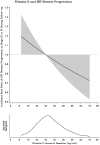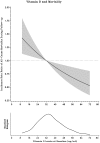Vitamin D status of HIV-infected women and its association with HIV disease progression, anemia, and mortality
- PMID: 20098738
- PMCID: PMC2808247
- DOI: 10.1371/journal.pone.0008770
Vitamin D status of HIV-infected women and its association with HIV disease progression, anemia, and mortality
Abstract
Background: Vitamin D has a potential role in slowing HIV disease progression and preventing mortality based on its extensive involvement in the immune system; however, this relationship has not been examined in large studies or in resource-limited settings.
Methodology/principal findings: Vitamin D levels were assessed in 884 HIV-infected pregnant women at enrollment in a trial of multivitamin supplementation (not including vitamin D) in Tanzania. Women were followed up for a median of 69.5 months, and information on hemoglobin levels, HIV disease progression, and mortality was recorded. Proportional hazard models and generalized estimating equations were used to assess the relationship of these outcomes with vitamin D status.
Conclusions/significance: Low vitamin D status (serum 25-hydroxyvitamin D<32 ng/mL) was significantly associated with progression to WHO HIV disease stage III or greater in multivariate models (incidence rate ratio [RR]: 1.25; 95% confidence intervals [CI]: 1.05, 1.50). No significant relationship was observed between vitamin D status and T-cell counts during follow-up. Women with low vitamin D status had 46% higher risk of developing severe anemia during follow-up, compared to women with adequate vitamin D levels (RR: 1.46; 95% CI: 1.09, 1.96). Women in the highest vitamin D quintile had a 42% lower risk of all-cause mortality, compared to the lowest quintile (RR: 0.58; 95% CI: 0.40, 0.84). Vitamin D status had a protective association with HIV disease progression, all-cause mortality, and development of anemia during follow-up in HIV-infected women. If confirmed in randomized trials, vitamin D supplementation could represent a simple and inexpensive method to prolonging the time to initiation of antiretroviral therapy in HIV-infected patients, particularly in resource-limited settings.
Conflict of interest statement
Figures
References
-
- DeLuca HF. Metabolism and molecular mechanism of action of vitamin D: 1981. Biochem Soc Trans. 1982;10:147–158. - PubMed
-
- Stroder J. Immunity in vitamin D deficient rickets. Vitamin D and problems of uremic bone disease. Berline: de Gruyter; 1975. pp. 675–687.
-
- Bhalla AK, Amento EP, Clemens TL, Holick MF, Krane SM. Specific high-affinity receptors for 1,25-dihydroxyvitamin D3 in human peripheral blood mononuclear cells: presence in monocytes and induction in T lymphocytes following activation. J Clin Endocrinol Metab. 1983;57:1308–1310. - PubMed
-
- Liu PT, Stenger S, Li H, Wenzel L, Tan BH, et al. Toll-like receptor triggering of a vitamin D-mediated human antimicrobial response. Science. 2006;311:1770–1773. - PubMed
-
- Liu PT, Stenger S, Tang DH, Modlin RL. Cutting edge: vitamin D-mediated human antimicrobial activity against Mycobacterium tuberculosis is dependent on the induction of cathelicidin. J Immunol. 2007;179:2060–2063. - PubMed
Publication types
MeSH terms
Substances
Grants and funding
LinkOut - more resources
Full Text Sources
Medical



